.jpg)
Key Takeaways:
- Impaction in leopard geckos can occur when mealworms are consumed and not properly digested, leading to blockages in the digestive system.
- Poor husbandry, such as inadequate tank setup and temperature regulation, can contribute to the risk of impaction in leopard geckos.
- Overfeeding and offering oversized mealworms can increase the chances of impaction in leopard geckos, as these worms have hard, indigestible shells.
Introduction
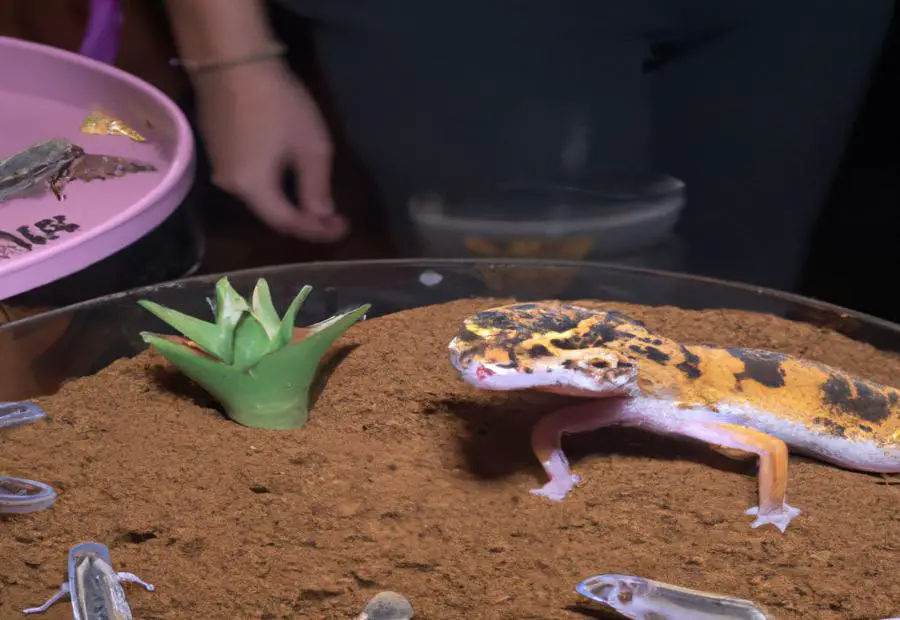
Photo Credits: Petbrilliant.Com by Andrew Green
Feeding leopard geckos mealworms is a common practice, but what are the potential risks involved? In this introduction, we will provide an overview of the topic and highlight the importance of understanding the potential risks of feeding mealworms to leopard geckos. Stay tuned to discover crucial information that will help keep your leopard geckos healthy and safe.
Overview of the topic
Leopard geckos are vulnerable to impaction from eating mealworms. Impaction is a block in the digestive system due to indigestible substances. This can be dangerous and must be managed fast. Reptile owners must be aware of potential risks.
Poor husbandry, hard shells, overfeeding, and oversized mealworms can all contribute to impaction. To prevent it, set up the tank correctly and provide a balanced diet with different insects. Pro Tip: Gut-load mealworms with nutrition prior to feeding. That way, leopard geckos get good nutrition and reduce the risk of impaction.
Importance of understanding the potential risks of feeding mealworms to leopard geckos
The need to understand the dangers of feeding mealworms to leopard geckos is very important. Impaction is one of the main risks and can be fatal.
Improper tank setup and temperature control, along with the indigestible shells of mealworms, increases the risk of impaction. To prevent this, the right environment and feeding practices must be provided.
It is advised to stick to the recommended feeding instructions. When feeding mealworms, extra attention should be paid to reducing risks of impaction. Alternatives, like superworms, should be taken into consideration. Size and nutritional value should be taken into account. Other feeder insects should also be incorporated into their diet.
In summary, understanding the risks of mealworms is key for leopard gecko health. With proper husbandry, a balanced diet, and alternative feeder insects, owners can reduce the dangers of impaction. So, be prepared to face the world of mealworm mischief and take measures to keep leopard geckos healthy.
Understanding impaction in leopard geckos
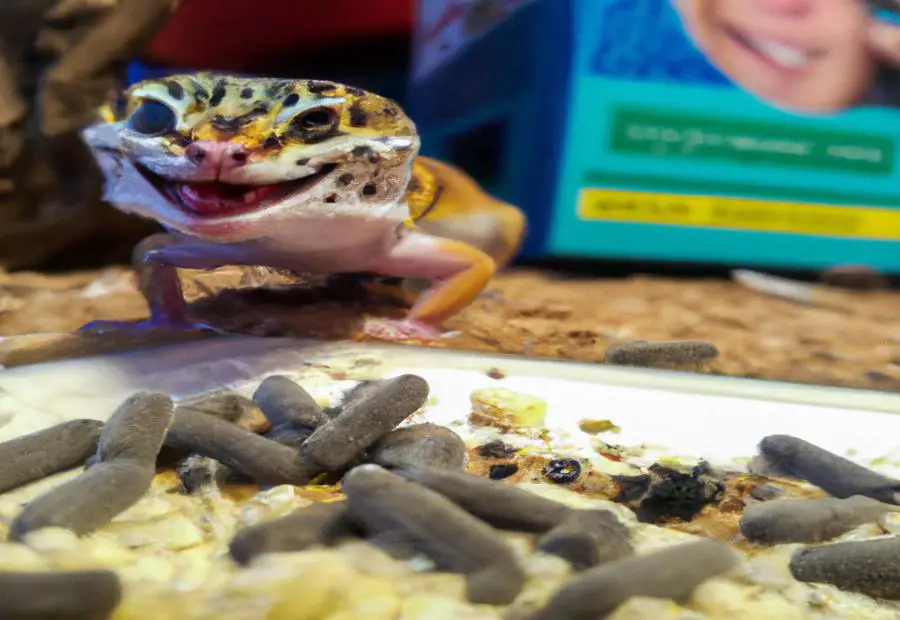
Photo Credits: Petbrilliant.Com by Brandon Lewis
Impaction in leopard geckos is a serious concern that every owner should be aware of. In this section, we will delve into the concept of impaction – what it is and why it poses a risk to leopard geckos. We will explore the potential causes and consequences of impaction, providing valuable insights into the health and well-being of these fascinating reptiles.
What is impaction?
Impaction is a problem for leopard geckos. It happens when their digestive system gets blocked by large or indigestible items. This can cause big health issues and even death if not taken care of quickly. Leopard geckos have small digestive systems and feed habits that make them prone to impaction. Poor husbandry practices, like having an unsuitable tank setup with inadequate substrate depth or bad temperature regulation, can make digestion harder and increase the chances of impaction. Also, hard, indigestible mealworm shells can build up in their guts, leading to blockages and pain.
Overfeeding and giving too-big mealworms to leopard geckos also increases the risk of impaction. Geckos can’t regulate their own food intake, so they might eat more than they can handle. Plus, large mealworms are harder to digest.
So, to prevent impaction, you need proper tank setup and temperature regulation. You should also give your gecko a balanced diet with plenty of variety. Mealworms should not be the only food source. Superworms are an alternative with higher nutrients. But, you should consider cost, availability and preferences when deciding. Remember, balance is essential for your gecko’s health.
Why worry about impaction? Because it won’t make your gecko happy and they won’t be able to show off their moves with a blocked tummy!
Why is impaction a concern for leopard geckos?
Impaction is a major worry for leopard geckos as it can have serious health consequences. It occurs when a blockage forms in the gastrointestinal tract, making it hard for food and waste to pass through. This can cause discomfort, loss of appetite, and even life-threatening problems like organ damage. Leopard geckos are more prone to impaction because of their small size and delicate digestive systems. It’s vital to understand and prevent impaction for them to stay healthy.
Factors like poor husbandry contribute to impaction. An unsuitable tank setup, bad substrate, or incorrect temperature regulation can cause impaction. For example, if the substrate is loose or compactable, the gecko may swallow it while eating mealworms, leading to a blockage. Temperature extremes also affect digestion and motility, making leopard geckos more vulnerable.
Mealworms’ hard and indigestible shells are another risk factor. Geckos usually swallow prey whole without chewing, so their digestive system needs to break food down properly. But mealworms’ tough exoskeletons can be hard to digest. If these indigestible bits don’t break down, they can build up and lead to impaction.
Overfeeding and oversized mealworms can also cause impaction. Giving too much food or large mealworms can overwhelm their digestive system and lead to improper digestion and bowel movements. Owners should know how to feed their leopard geckos correctly and use an appropriate portion size to avoid potential impaction risks.
In short, impaction is a serious problem for leopard geckos. Poor husbandry, mealworms’ shells, and overfeeding can all cause impaction. Owners must take steps to set up the tank correctly, regulate the temperature, and feed their geckos properly. Alternatives like superworms can also help reduce the risk of impaction and keep their pets healthy. Feeding mealworms to leopard geckos is like playing Russian roulette with their digestive system.
Factors contributing to impaction from mealworms
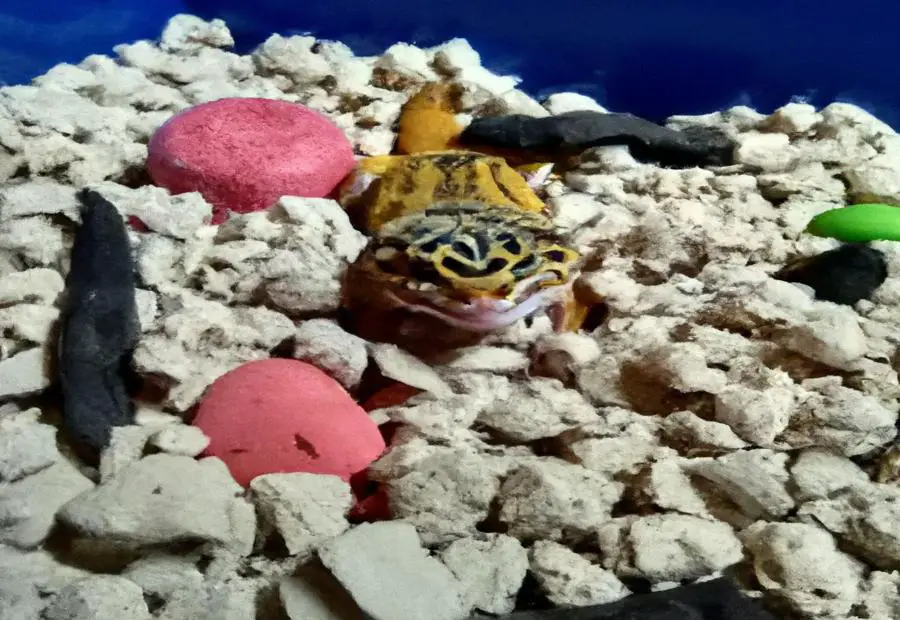
Photo Credits: Petbrilliant.Com by Zachary King
Factors contributing to impaction from mealworms: Discover the role of poor husbandry, risks associated with hard shells, and the dangers of overfeeding and oversized mealworms.
The role of poor husbandry in impaction
Husbandry practices can be a major factor in the occurrence of impaction for leopard geckos. Inadequate tank setup and temperature regulation can disturb their digestive system. If they’re not in an environment that meets their needs, it can affect passing waste. Ensure proper tank setup and temperature control for their health.
Plus, the food fed to them is a factor in the risk of impaction. Mealworms are popular but have shells that are hard and indigestible. If not broken down or chewed by the gecko, blockages can occur. Overfeeding and large mealworms can increase the risk too.
Leopard gecko owners must know about the risks of bad husbandry and feeding habits. Provide a balanced diet with nutritious feeder insects. Research and understand proper feeding practices to look after their health.
To reduce impaction risk, ensure proper husbandry practices and diversify their diet. Take precautions and stay informed on responsible practices to make sure your leopard gecko is healthy and happy. Say no to mealworms and be a responsible owner!
Risks associated with hard, indigestible shells of mealworms
Mealworms have hard, indigestible shells. These pose a risk to leopard geckos as they can cause impaction. Impaction is when the gecko’s digestive system gets blocked, leading to serious health issues. Poor husbandry practices can add to the risk. Inadequate tank setup and temp. regulation can affect digestion, making the gecko more vulnerable to impaction. Overfeeding and oversized mealworms are a big no-no.
The hard, indigestible shells are particularly concerning as they can be life-threatening if not addressed in time. Leopard gecko owners must be aware of these risks and take safety measures to prevent impaction. A case in point is when an owner fed their pet too many mealworms without accounting for the size and indigestible nature of the shells. This caused severe impaction and required immediate vet attention.
To minimize the risks of impaction, leopard gecko owners should:
- create a proper tank setup with appropriate temperature regulation.
- offer a balanced diet with other feeder insects besides mealworms.
- Carefully select the right-sized worms during feedings.
By following these guidelines, owners can help reduce the likelihood of impaction and promote healthier outcomes for their reptiles.
Overfeeding and oversized mealworms as factors for impaction
Leopard geckos have small digestive systems. So, overfeeding or giving them oversized mealworms can lead to impaction. This can cause health issues like loss of appetite, constipation, and even death. To avoid this, it’s important for owners to be careful of the size and quantity of mealworms they give their pets.
Preventing impaction in leopard geckos
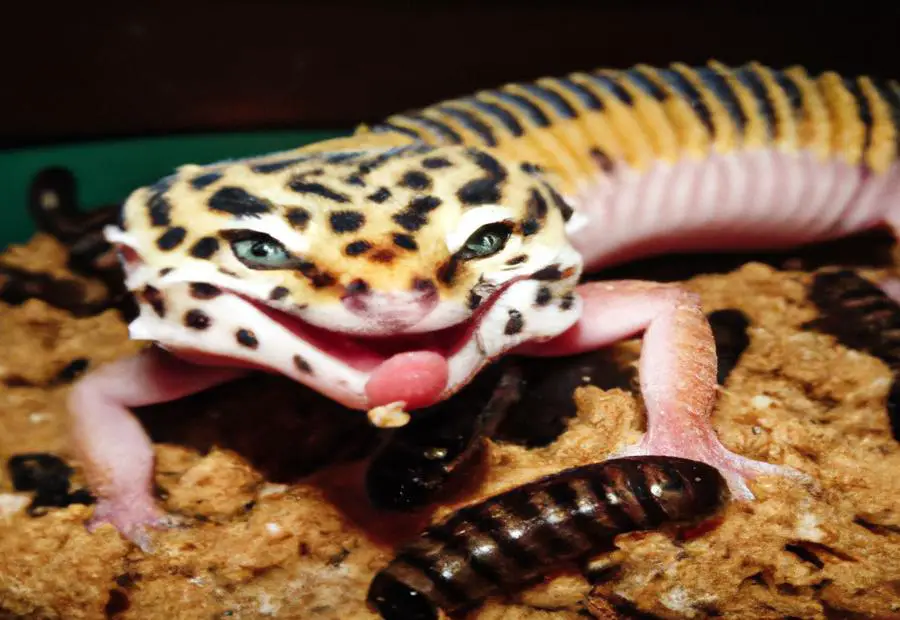
Photo Credits: Petbrilliant.Com by Willie White
Proper tank setup, a balanced diet, and minimizing risks – all crucial in preventing impaction in leopard geckos. We’ll dive into the importance of tank setup and temperature regulation, feeding recommendations for a balanced diet, and tips to safely feed mealworms to leopard geckos, reducing the risks of impaction. Stay informed to ensure the well-being of your gecko friend!
Importance of proper tank setup and temperature regulation
For leopard gecko wellness, proper tank setup and temperature regulation are musts. To guarantee their health, their habitat must have proper ventilation, heating and lighting. Leopard geckos are ectothermic and need external heat to regulate their body temperature. Thus, a stable temperature gradient must be established in the tank for the geckos to thermoregulate by moving between cooler and warmer areas – this is important for digestion and metabolism.
When setting up the tank, size should be suitable for the geckos to move around comfortably. Substrate should also be chosen carefully to keep the tank clean and stop foreign materials from being ingested. Additionally, hides, rocks, branches and other decorations should be added to create a diverse environment that mirrors their natural habitat and reduces stress.
Reliable heating equipment, like heat mats or lamps, should be used to guarantee stable temperatures. Monitoring thermal gradients allows for quick adjustments, creating warmer basking areas and cooler retreats.
To guarantee leopard geckos stay healthy, it’s important to understand tank setup and temperature regulation. By maintaining an optimal habitat with temperatures that meet their needs, we can ensure they thrive in captivity. Also, to increase their dietary variety and stop them from eating only mealworms, a variety of insects should be introduced.
Feeding recommendations for a balanced diet and variety of insects
Giving leopard geckos a nutritious diet with many different insects is essential for their health and happiness. It’s important to think of impaction risks and nutrition when planning their meals.
Feed them crickets, dubia roaches, and waxworms to get all the nutrients they need. Don’t feed too much to prevent obesity and health troubles. Appropriately portion out the food for the gecko’s age and size.
Every gecko has different dietary needs, so talk to a reptile vet for tailored advice. As you introduce new insects, do it slowly to give their tummy time to adjust.
Tips for feeding mealworms to leopard geckos to minimize the risks of impaction
Mealworms can be a popular food for leopard geckos, but there are risks. The main one is impaction, when indigestible material blocks the digestive system. To reduce this risk, here are tips:
- Firstly, ensure the tank setup and temperature are good. This includes correct temps and substrate that lets geckos burrow.
- Also, offer a balanced diet with different insects. This means not just mealworms, but adds nutrients, vitamins and minerals.
- Change mealworm feeding practices too. This includes avoiding overfeeding and giving appropriately-sized worms. Try softer alternatives like superworms.
By doing these, owners can reduce the risk of impaction when feeding mealworms. However, research and responsible feeding are important to keep leopard geckos healthy.
Alternatives to mealworms for leopard geckos
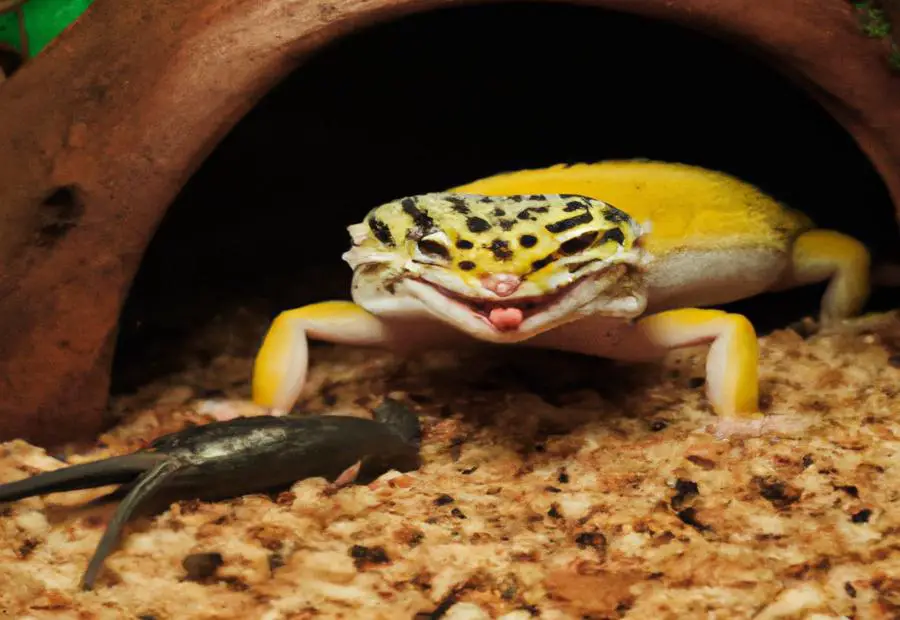
Photo Credits: Petbrilliant.Com by Robert Allen
Looking for alternatives to mealworms for your leopard geckos? Discover the benefits of superworms, a more nutritious option, along with factors to consider when choosing between mealworms and superworms. Plus, find out how to balance your gecko’s diet with other feeder insects. Expand your knowledge on providing a varied and healthy diet for your leopard geckos.
Superworms as a more nutritious option
Superworms are an optimal choice for feeding leopard geckos. These larvae of the darkling beetle have multiple advantages, especially in terms of nutrition.
For example, they contain more protein and fat than mealworms, so leopard geckos get essential amino acids and energy. Plus, their exoskeleton is softer, reducing the risk of impaction.
What’s more, superworms come in various sizes, making it easier to pick the right one for your gecko. With this, you can ensure a balanced and nutritious meal.
Remember, every leopard gecko has different needs and preferences. Get advice from an expert to make sure you meet yours. That way, you’ll provide optimal nutrition and avoid impaction risks.
Factors to consider when choosing between mealworms and superworms
Choosing the right feeder insects for leopard geckos is essential. Decide between mealworms and superworms to meet their nutritional needs. Look at these factors for an informed decision:
- Nutritional Content: Mealworms have moderate levels of protein and fat. Superworms provide more.
- Digestibility: Mealworms have hard shells, so they can cause impaction. Superworms have softer shells, making them easier to digest.
- Size Considerations: Superworms are larger than mealworms. This may be too big for younger or smaller geckos.
- Preferences: Geckos may prefer the taste or texture of one over the other.
Consider all these factors for the best diet. Offer variety for a diverse diet and to prevent nutrient deficiencies. Prevent impaction by avoiding mealworms!
Balancing the diet with other feeder insects
Leopard geckos can thrive when their diet is varied and balanced. This includes different types of feeder insects, such as crickets, waxworms, and roaches. Each type has its own unique nutrition, with essential vitamins, minerals, and protein. Feeder insects add variety and prevent boredom.
The size of the prey is important. Larger prey should be for adult geckos. Mealworms are easy to get and care for, but they shouldn’t be the only food source. This can lead to growth issues or metabolic bone disease.
Reptile owners are educating others on this. Balance is key for a healthy gecko and also for saving on vet bills.
Conclusion
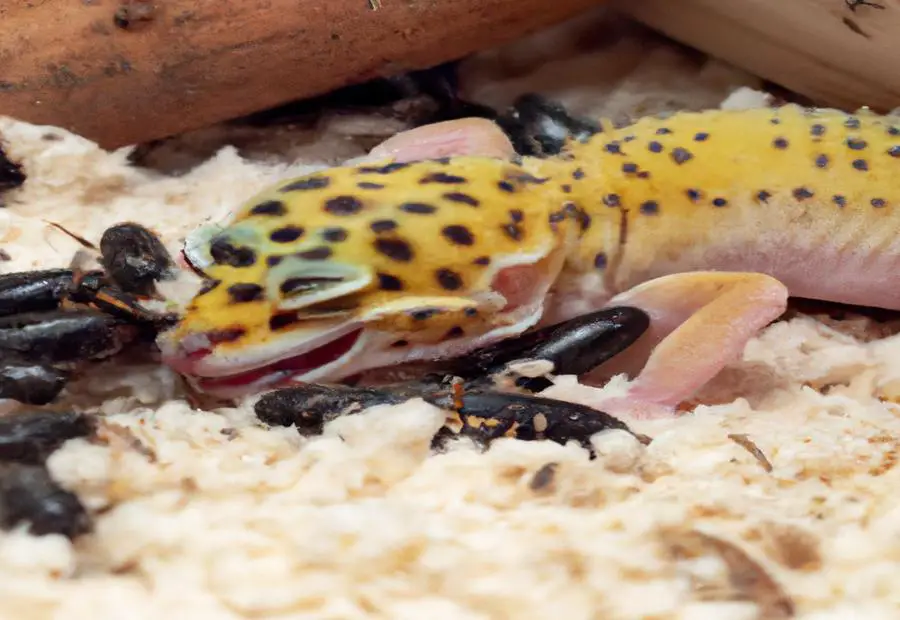
Photo Credits: Petbrilliant.Com by Eugene Jones
In the conclusion, we summarize key points and emphasize the importance of informed research and responsible feeding practices for the health and well-being of leopard geckos. We also issue a call to action for reptile enthusiasts to take steps in reducing the risk of impaction in leopard geckos. Remember, being mindful of their diet is crucial in ensuring the overall health and longevity of these incredible creatures. Let’s make a difference and create a safer environment for our leopard geckos.
Summary of key points
Impaction is a blockage in the digestive system of leopard geckos, and is a serious health issue. Poor husbandry practices, such as inadequate tank setup and temperature regulation, can contribute to impaction. Mealworms, with their hard shells, can cause impaction if they build up in the digestive tract. Overfeeding mealworms, or feeding worms bigger than what the gecko can eat, can further contribute to impaction.
To prevent impaction, provide proper tank setup and the right temperature. Also, offering various insects will ensure a balanced diet. When feeding mealworms, do not overfeed and only give them the right size.
Superworms have higher protein content and are a more nutritious alternative to mealworms. Consider nutrition and ease of digestion when choosing between mealworms and superworms. Additionally, include other feeder insects such as crickets or dubia roaches in the diet.
To care for leopard geckos properly, understand the risks of feeding them mealworms. Good husbandry, proper feeding practices, and alternative feeder insects will help minimize the risk of impaction. Do research and practice responsible feeding habits for optimal care. Knowledge is power when feeding reptiles. Keep those gecko bellies happy!
Importance of informed research and responsible feeding practices for leopard geckos’ health and well-being
Informed research & responsible feeding practices are paramount for leopard geckos’ health & well-being. Hence, knowing the risks of feeding mealworms to these reptiles is essential. Impaction – a blockage in their digestive system – is a major issue. It arises from bad husbandry, hard shells that are tough to digest & overfeeding/oversized mealworms. To prevent impaction, set up the tank properly, regulate the temperature & feed a balanced diet with various insects. This includes minimizing the risks of feeding mealworms to leopard geckos.
To ensure the reptiles’ health & well-being, informed research on their dietary needs must be done. This includes understanding the risks of mealworms – a source of impaction. Poor husbandry, improper tank setup, temperature regulation & hard shells complicate digestion for leopard geckos. Also, oversized mealworms & overfeeding increase the risk of impaction.
To protect leopard geckos from impaction, responsible feeding practices must be followed. The tank must be set up & temperature regulated correctly. Feed a balanced diet with various insects to ensure adequate nutrition. While mealworms are popular, caution must be taken when offering them. Minimise the risk of impaction by selecting appropriately sized mealworms & not overfeeding them.
Call to action for reptile enthusiasts to reduce risk of impaction in leopard geckos
Reptile fans, it is crucial to take action to reduce the risk of impaction in leopard geckos. Their digestive system is vulnerable, making this a serious issue. Mealworms are often fed, but if not handled properly, they can contribute to the problem. Here’s a 5-step guide to help:
- Create a suitable environment for healthy digestion.
- Offer a variety of nutritious meals to meet the gecko’s needs. Cut down on mealworms.
- Be aware that hydration and substrate choices can cause impaction. Practice good husbandry.
- Don’t overfeed or give oversized mealworms.
- Consider gut-loaded or dusted mealworms. Try tong-feeding for safe ingestion.
Superworms offer a more nutritious option than mealworms. Consider nutritional content and size when choosing. Different feeder insects should also be included.
We have a responsibility to prioritize the health of leopard geckos. By following good practices and diversifying their diet, we can ensure their digestive safety. One reptile enthusiast implemented a variety of insects and saw improved digestion and health in their geckos! Let’s join together to make a difference.
Some Facts About “Can Mealworms Cause Impaction in Leopard Geckos”:
- ✅ Mealworms can cause impaction in leopard geckos if they have hard, indigestible shells or if they are overfed. (Source: Regal Reptiles)
- ✅ Impaction is a condition where the leopard gecko’s intestines are blocked by something indigestible and can be fatal if left untreated. (Source: Regal Reptiles)
- ✅ Proper husbandry, including providing a warm side in the tank and a varied diet, can help prevent impaction from feeding mealworms to leopard geckos. (Source: Reptile Jam)
- ✅ Mealworms should be fed in moderation and alongside other feeder insects to provide a balanced diet and prevent nutritional deficiencies. (Source: GeckoPedia)
- ✅ Superworms are generally a better option than mealworms for leopard geckos as they have a better nutrient profile and a lower risk of impaction. (Source: GeckoAdvice)
FAQs about Can Mealworms Cause Impaction In Leopard Geckos
Can mealworms cause impaction in leopard geckos?
Yes, mealworms can cause impaction in leopard geckos if they have hard, indigestible shells, if they are overfed, or if they are too large. It is best to feed geckos mealworms that have recently shed their shells and have a soft texture. Overfeeding can lead to digestive issues and obesity, which can eventually cause impaction. Feeding geckos oversized mealworms can also lead to impaction.
What is the immediate cause of impaction in leopard geckos?
The immediate cause of impaction in leopard geckos is when something indigestible, such as a mealworm shell or substrate material like sand, blocks their intestines. If left untreated, impaction can be potentially deadly for the geckos.
How can I prevent impaction in leopard geckos?
To prevent impaction in leopard geckos, it is recommended to feed them mealworms that have recently shed their shells, feed them the right amount, feed them appropriately sized mealworms, place the mealworms on a substrate-free surface, and provide a varied diet with other feeder insects. Additionally, ensuring proper heating and a balanced diet with calcium supplements can help maintain their digestive health.
What are the risks associated with feeding mealworms to leopard geckos?
There are potential risks associated with feeding mealworms to leopard geckos, such as calcium deficiencies, obesity, and the transmission of parasites or bacteria. It is important to source mealworms from reliable suppliers and dust them with supplements before feeding. Providing a balanced and varied diet, along with proper care and understanding of the gecko’s needs, will minimize these risks.
Are there alternative feeder insects to mealworms for leopard geckos?
Yes, there are alternative feeder insects to mealworms for leopard geckos. Super worms, hornworms, and waxworms are some examples. It is important to provide a variety of insects in the gecko’s diet to ensure a balanced and nutrient-rich intake.
What are the storage practices for mealworms?
To store mealworms, they should be refrigerated in a well-ventilated container with wheat bran and fed a carrot once a week. It is important to keep them at low temperatures to prevent them from turning into beetles. Superworms, on the other hand, can be kept in a well-ventilated container with wheat bran and fed a carrot, but they should not be stored with mealworms as they can eat them.
